BURUNDI
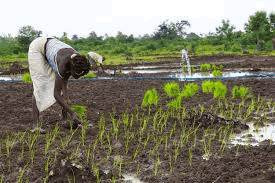 Summary of SRI in Burundi
Summary of SRI in Burundi
Training on the System of Rice Intensification has been ongoing in Burundi since 2010. The International Fund for Agriculture and Development's (IFAD) PAIVA-B project (Projet d'appui à l'intensification et à la valorisation agricoles du Burundi) implemented SRI in the Karusi and Ngozi provinces with over 2,600 farmers. Projects reported rice yields increasing for one to five tons per hectare at that time. Flooded Cellar Productions created a video that highlights some of the principles of SRI and some of the successes and impacts of SRI on farmers in Burundi. (Additional Flooded Cellar videos) are located on their YouTube channel in English and French.
In collaboration with the Burundi government, IFAD has continued their support of SRI in several areas, including, among others, Karusi, Ngozi and Bujumbura provinces.
During 2017, The provinces Bujumbura, Cankuzo and Ruyigi have recorded significant results through PROPA-O Project. In the province of Bujumbura, PROPA-O promoted SRI during 2017 to 246 rice farmers on 96 ha. in the Mutimbuzi commune, which is located in the Maramvya-Kirekura area. In 2019, The PNSADR-IM, funded by IFAD, the Global Agriculture and Food Security Program (GAFSP), the OPEC Fund for International Development (OFID) and the Government of Burundi, Farmer Field Schools (FFS) have helped rice farmers in Gihanga commune to significantly increase production with SRI. Beginning in 2018, Inades-Formation Burundi successfully promoted SRI in three rice cooperatives in Maramvya in the commune of Mutimbuzi in the west of the country, and in Kabo and Kibaba in the commune of Nyanza-lac in the south of the country. The average rice yield obtained with the SRI technique was 6.5 tons/ha compared with 4 tons/ha for traditional rice production practices.
Progress and Activities
2021 Updates
 PNSADR-IM has a Positive Outcome in the Imbo Region
PNSADR-IM has a Positive Outcome in the Imbo Region
[July 30, 2021] According to an article in Journal Burundi Eco the achievements of the National Program for Food Security and Rural Development of the Imbo and Moso regions (PNSADR-IM) are estimated at 90% in the Imbo as of now --10 months before its closing. The six-year government program, which is financed unded by IFAD, the Global Agriculture and Food Security Program (GAFSP), and the OPEC Fund for International Development (OFID), has been strengthening the food security 9 communes of the Imbo and Moso region since 2015.
"Blessed be he who taught us SRI," says Jean Pierre Ndayishimiye, a rice seed multiplier in Mutimbuzi commune, Bujumbura province. In his commune, the PNSADR-IM rehabilitated an 808 hectare marsh and extended it by 202 hectares. For Ndayishimiye, before the PNSADR-IM intervention, traditional rice cultivation allowed him to harvest 30 to 40 kg of paddy rice on an area of one hectare. However, since 2019 when he started practicing SRI, he harvested 8 tonnes of paddy rice per hectare. The PNSADR-IM also made improvements in water distribution and regulation; provided storage structures, rice hullers, and credit access; and assistance with other crops. [For more information on PNSADR-IM accomplishments, read full French language article.]
2020
 Inades-Formation Burundi Extends SRI in Mutimbuzi and
Nyanza-lac Communes
Inades-Formation Burundi Extends SRI in Mutimbuzi and
Nyanza-lac Communes
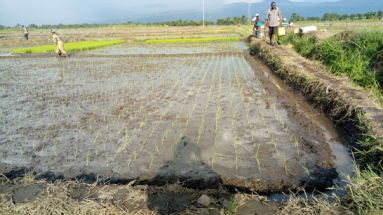 In order to increase rice production in the developed marshes, Inades-Formation Burundi successfully promoted SRI in three rice cooperatives in Maramvya in the commune of Mutimbuzi in the west of the country, and in Kabo and Kibaba in the commune of Nyanza-lac in the south of the country. One hundred and twenty rice growers from the three rice cooperatives were initially trained in the SRI technique. After the theoretical and practical training, held in December 2018 and 2019, the participating rice farmers set up SRI plots of about 14.5 ha in the three marshlands (Kibaba, Kabo and Maramvya) near conventionally-planted fields in order to allow comparison between yields.
While the average rice yield without SRI was less than 4 tons/ha depending on the locality, the average rice yield obtained with the SRI technique was 6.5 tons/ha. Rice yield doubled or even tripled for some farmers in the three rice cooperatives of Maramvya, Nyanza-lac and Kabo during the 2018 and 2019 growing seasons. The production obtained has thus made it possible to recoup the high investments of the hydro-agricultural works carried out in the project’s areas of action.
In order to increase rice production in the developed marshes, Inades-Formation Burundi successfully promoted SRI in three rice cooperatives in Maramvya in the commune of Mutimbuzi in the west of the country, and in Kabo and Kibaba in the commune of Nyanza-lac in the south of the country. One hundred and twenty rice growers from the three rice cooperatives were initially trained in the SRI technique. After the theoretical and practical training, held in December 2018 and 2019, the participating rice farmers set up SRI plots of about 14.5 ha in the three marshlands (Kibaba, Kabo and Maramvya) near conventionally-planted fields in order to allow comparison between yields.
While the average rice yield without SRI was less than 4 tons/ha depending on the locality, the average rice yield obtained with the SRI technique was 6.5 tons/ha. Rice yield doubled or even tripled for some farmers in the three rice cooperatives of Maramvya, Nyanza-lac and Kabo during the 2018 and 2019 growing seasons. The production obtained has thus made it possible to recoup the high investments of the hydro-agricultural works carried out in the project’s areas of action. In view of the good results obtained during the first trials of the SRI, the number of rice growers who have adopted the SRI has increased from 165 to 587. In view of the more than satisfactory results, Inades-Formation Burundi will continue to disseminate SRI in all areas where the beneficiary members of the three cooperatives cultivate rice. The introduction of SRI in the three cooperatives supported by Inades-Formation Burundi was carried out within the framework of the programme Promotion of food sovereignty and women’s participation in rural Burundi, financed by the Basque Government. [See full articles on the website in French and English]
2019
 PNSADR-IM: Cooperatives and Good Agricultural Practices Increase Production and Improve Household Living Conditions
PNSADR-IM: Cooperatives and Good Agricultural Practices Increase Production and Improve Household Living Conditions
[July 5, 2019] Funded by the International Fund for Agricultural Development (IFAD), the Global Agriculture and Food Security Program (GAFSP), the OPEC Fund for International Development (OFID) and the Government of Burundi, the PNSADR-IM has been working in the Imbo region more than three years with the dairy and rice cooperatives in the communes of Mpanda, Buganda, Rugombo, Gihanga and Mutimbuzi to improve the living conditions of households. Recently, Farmer Field Schools (FFS) have allowed rice farmers in Gihanga commune to significantly increase production. The FFS is a comparative approach between the traditional practices and the System of Rice Intensification, which helps farmers to better understand why to adopt better practices. Farmers have reportedly seen that SRI gives them good production without spending a lot of money. [For more information, read full French language article]
2017
 PROPA-O
Project Makes Progress with SRI
and Other Activities
PROPA-O
Project Makes Progress with SRI
and Other Activities
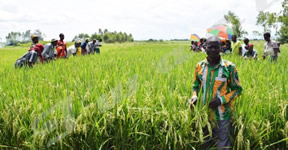 [August 24,2017] According to an IWACU article, PROPA-O* Project, which aims to eradicate malnutrition and achieve food security, is making significant progress; beneficiaries say they are satisfied. Swamps have been developed, storage facilities have been constructed and animals have been distributed. The activities are intended to not only increase production, but establish access to markets.
In the Mutimbuzi Marsh, farmers hope to produce more by adopting SRI. In particular, the provinces Bujumbura, Cankuzo and Ruyigi have recorded significant results. In the province of Bujumbura, PROPA-O has promoted SRI with 246 rice farmers on 96 ha. in the Mutimbuzi commune, which is located in the Maramvya-Kirekura area. To do this, the project rehabilitated the Muzazi Dam, constructed irrigation and drainage works to capture water on the Muzazi River in order to irrigate the rice fields: "Before there were only fields of beans and corn. Rice cultivation based on SRI techniques is new in the region," according to Privat Baranjeguye, head of the agriculture and infrastructure component.
[August 24,2017] According to an IWACU article, PROPA-O* Project, which aims to eradicate malnutrition and achieve food security, is making significant progress; beneficiaries say they are satisfied. Swamps have been developed, storage facilities have been constructed and animals have been distributed. The activities are intended to not only increase production, but establish access to markets.
In the Mutimbuzi Marsh, farmers hope to produce more by adopting SRI. In particular, the provinces Bujumbura, Cankuzo and Ruyigi have recorded significant results. In the province of Bujumbura, PROPA-O has promoted SRI with 246 rice farmers on 96 ha. in the Mutimbuzi commune, which is located in the Maramvya-Kirekura area. To do this, the project rehabilitated the Muzazi Dam, constructed irrigation and drainage works to capture water on the Muzazi River in order to irrigate the rice fields: "Before there were only fields of beans and corn. Rice cultivation based on SRI techniques is new in the region," according to Privat Baranjeguye, head of the agriculture and infrastructure component.Following a 10-day SRI training in December 2106, Gabriel Ntampera, applied the lessons in his 27 are field. "With 2 kilograms of Watt rice seeds planted, I harvested 950 kilograms and 1,124 kilograms on two kilograms planted with V1380." For him, the SRI technique has several advantages. First of all, it saves seeds: "2kg was enough while before I used 20kg on a field of the same dimensions", to increase production yields, going from single to double, while reducing by half the water requirements of the plant. "A seed yields several plants. This means that 1 kilogram can produce between 800 and 900 kilos of rice. The production takes only 140 days including the time of the nurseries, which allows me to practice two rice seasons per year, "he says. Besides the cultivation of rice in the marsh, PROPA-O distributed cows and pigs in this commune. The cow dung helps fertilize the field. [* PROPA-O is a project of the Burundi Government financed by the commission of the European Union for a duration of 58 months. It covers 8 provinces of the Imbo and Moso regions: Cibitoke, Bubanza, Bujumbura, Bururi, Makamba, Rutana, Ruyigi and Cankuzo. It is under the supervision of IFAD and its implementation involves PRODEFI, ACORD and CAPAD NGOs as well as three agencies of the United Nations system: FAO, WFP and UNICEF].
 IFAD Extends SRI Methods through the Imbo and Moso National Program for Food Security and Rural Development (PNSADR-IM)
IFAD Extends SRI Methods through the Imbo and Moso National Program for Food Security and Rural Development (PNSADR-IM)
[July 20, 2017]
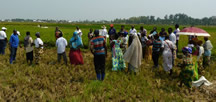 According to an Ikiriho news article and video, the International Fund for Agricultural Development (IFAD) is committed to strengthening the capacity of rice farms through the Imbo and Moso National Program for Food Security and Rural Development (PNSADR-IM). In the Buhinyuza rice fields of the Ntahangwa commune in the Kinama area, 79 rice farmers in four Champs Ecole Producteurs (CEP) have been studying SRI since April. "In this system, we use a new approach known as CEP to introduce producers to technical innovations," said Thérence Niyondagara, who is in charge of PNSADR-IM. "Thanks to the 15 master trainers from the different Provincial Directorates of Agriculture who were trained by a Beninese specialist, these 79 farmers were able to benefit from this knowledge," he added.
According to the officials of the Provincial Directorates of Agriculture and Livestock (DPAE) who received the training, the CEP uses a comparative approach to highlight differences between the traditional practice and SRI.
According to an Ikiriho news article and video, the International Fund for Agricultural Development (IFAD) is committed to strengthening the capacity of rice farms through the Imbo and Moso National Program for Food Security and Rural Development (PNSADR-IM). In the Buhinyuza rice fields of the Ntahangwa commune in the Kinama area, 79 rice farmers in four Champs Ecole Producteurs (CEP) have been studying SRI since April. "In this system, we use a new approach known as CEP to introduce producers to technical innovations," said Thérence Niyondagara, who is in charge of PNSADR-IM. "Thanks to the 15 master trainers from the different Provincial Directorates of Agriculture who were trained by a Beninese specialist, these 79 farmers were able to benefit from this knowledge," he added.
According to the officials of the Provincial Directorates of Agriculture and Livestock (DPAE) who received the training, the CEP uses a comparative approach to highlight differences between the traditional practice and SRI. The news article explains that SRI gives farmers a good production without a lot of expense. "The system does not require a lot of seed as is the case with the old practice: only one seed can produce enough provided that the golden rule is respected," says Edmond Uwobikundiye of the CIBIToke DPEA. Rice growers who have been trained and supervised by master trainers in the rice-growing area of Buhinyuza prove their satisfaction by highlighting the benefits of the SRI. "We once spent more but did not expect an abundant harvest that can reward efforts and cost Says Jacqueline Niyonzima, Representative of the Associated CEP Tujehamwe, "Today, we have already found that SRI is far more productive than the old method," she adds. However, "SRI requires organic manure; we ask the government and anyone else who is able to give us livestock to help us out with the organic inputs," asks Survie Ndayirorere, Representative of the associated CEP Terimbere. [See article and video for details.]
 Farmers in Burundi Report on SRI Advantages
Farmers in Burundi Report on SRI Advantages
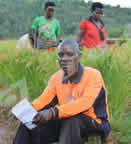 [July 7, 2017] According to an article in the IWACU online news, rice farmers in Burundi have found that SRI allows seed savings, increased production and good management of irrigation water. Privat Barajenguye, agricultural engineer with the International Fund for Agricultural Development (IFAD) noted that "Before it was introduced, 80 to 100 kg of seed was used per hectare. This has been reduced to no more than 12 to 20 kg on the same area." He added that a single plant transplanted at the young age, from 12 to 15 days max, will have between 50 to 60 thalli (tilllers). SRI ensures that production is doubled or even tripled and, where production was 3 to 4 tons per hectare, production now turns to ten tons.
[July 7, 2017] According to an article in the IWACU online news, rice farmers in Burundi have found that SRI allows seed savings, increased production and good management of irrigation water. Privat Barajenguye, agricultural engineer with the International Fund for Agricultural Development (IFAD) noted that "Before it was introduced, 80 to 100 kg of seed was used per hectare. This has been reduced to no more than 12 to 20 kg on the same area." He added that a single plant transplanted at the young age, from 12 to 15 days max, will have between 50 to 60 thalli (tilllers). SRI ensures that production is doubled or even tripled and, where production was 3 to 4 tons per hectare, production now turns to ten tons.Barajenguye specified that all varieties are compatible with this system, adding that good farming practices, including good soil leveling, spacing and water management are important. "If you plant too densely, the plants compete and choke each other." He adds that the SRI also requires perfect control of the water and thus allows its proper management; instead of a 10 cm water table, it is limited to 5 cm. "We go back after a week as soon as we see that the soil is more or less dry to irrigate again" notes the agricultural engineer, adding that it is not obligatory to leave the roots submerged in water.
Rice growers are enthusiastic. "Out of one hectare, the harvest was limited to a maximum of 1.5 tonnes. Currently, with the introduction of SRI, it is around 6 tons," says Claver Bucumi (right), chief of the Nyakijima II rice marsh in Ngozi, which has over three thousand rice farmers. "15 kg of seeds are currently enough for one ha." An TV interview with Bucumi about his SRI experience is posted on YouTube's Africa News channel. He is confident that this new system has revolutionized this area. The same goes for Gabriel, a rice farmer from Mutimbuzi commune, Bujumbura province. Over one ha, 120 kg or more of seed was used with the old seedling system, he recalls, and production was low. Today, on the same area, it needs only ten kg to harvest about ten tons. [See IWARU article for details.]
2014-2015 Updates
 Update on SRI Use in Burundi
Update on SRI Use in Burundi
Gilbert Bizimungu, who was a manager with the IFAD-supported PAIVA-B project (Project to Assist the Intensification and Validation of Agriculture in Burundi) when SRI was first introduced in Burundi in 2010 by two technical assistance teams from Madagascar, has reported that SRI methods have been raising paddy yields for farmers in his country from 1.5 t/ha on average to between 3 and 5 t/ha, depending on how many of the SRI practices are used, and how well they are used. A 2015 report on the PAIVA-B project notes that the SRI results have been especially successful in the marsh areas. A video produced for IFAD and SRI-Rice by Flooded Cellar Productions in the UK tells the story of SRI introduction, spread, methods and impact in Burundi. Bizimungu has provided the current brochure on the some SRI extension material recently published by the Ministere de l'Agriculture et de l'Elevage. The Fiche technique harmonisee pour la riziculture au Burundi, now available on the SRI-Rice website, describes the SRI practices which are being communicated to Burundian farmers.
2012-2013
 IFAD Projects Bring
SRI to Burundi's Karusi and Ngozi Provinces
IFAD Projects Bring
SRI to Burundi's Karusi and Ngozi Provinces
International Fund for Agricultural Development (IFAD) President Kanayo Nwanze and the second Vice President of the Republic of Burundi, M. Gervais Rufyikiri, recently visited two IFAD projects in the provinces of Karusi (central Burundi) and Ngozi (northern Burundi).
More than 2,600 farmers, including 50% women, have been applying System of Rice Intensification (SRI) methods on 150 hectares of marsh area in Nyabiho, Gitaramuka commune, Karusi province under the IFAD-funded PAIVA-B project (Projet d'appui à l'intensification et à la valorisation agricoles du Burundi) that supports agricultural intensification in Burundi. The beneficiaries, who have also formed a rice cooperative, said that yields have increased dramatically with SRI from one tonto five tons/hectare. They also use three hectares for seed multiplication.
Nwanzelors and Rufyikiri also visited the 94-hectare marsh area of Kigoma in Ngozi province, which would begin SRI development in 2012 with IFAD financing. As of now, six hectares are already being used to
 produce high quality seeds
with the SRI method under the IFAD funded PRODEFI (Programme de
développement des filières). (See
article in Afriquinfos and item on the website of
Burundi's president for more information.)
produce high quality seeds
with the SRI method under the IFAD funded PRODEFI (Programme de
développement des filières). (See
article in Afriquinfos and item on the website of
Burundi's president for more information.)The video SRI in East in Southern Africa (right)includes an interview with one of the farmers who adopted SRI in Karusi's Rusimbuko marsh after learning about it through the PAIVA-B project. The photo at left shows Mathilde (left side of photo), one of the farmers sent to Rwanda to learn about SRI, explaining the benefits of SRI to one of the local farmers interested in trying out the methods for herself.
Reports and Articles
- Naidoo, Indran A., Kouessi Maximin Kodjo, and Deirdre Mc Grenra. 2022. République du Burundi: Évaluation de la stratégie et du programme de pays. IFAD. March 22, 2022. 161p. [acessed May 7, 2022]
- TUO Foungnigué DAGNOGO. 2020. Burundi- Le Système de Riziculture Intensif (SRI): une aubaine pour les riziculteurs. Inades-Formation website. July 29. [English version: System of Rice Intensification (SRI): a godsend for farmers.] [SRI adopters have increased from 165 to 587 in 3 communes in West and South Burundi, Yields up from 4 to 6.5 tons/ha] [accessed April 29 2022]
- 2019. PNSADR-IM : Des coopératives pour l’amélioration des conditions de vie des ménages. BurundiEco. July 5.
- 2017. Burundi: Le marais de Nyavyamo donnera près de 5.380 tonnes de riz. Africa Generation News, August 15.
- Philemon, Nikobamye. 2017. Nouvelle technique de vulgarisation du riz chez FIDA, Ikiriho, Économie locale section, July 20.
- Ndabashinze, Rénovat . 2017. Le SRI révolutionne la riziculture. IWACU, July 7.
- Sinankwakure, Aloys. 2015. Problématique de l' adoption du système de riziculture intensive en milieu rural Burundaisis: Cas des riziculteurs de marais des communes Bugendana et Mutaho en région naturelle de Kirimiro. thesis (mémoire, Ingénieur Industriel), Université du Burundi, Institut Supérieur d' Agriculture
- 2015. Projet d'appui à l'intensification et à la valorisation agricoles du Burundi (PAIVA - B). International Fund for Agricultural Development IFAD (FIDA). [French language report of a supervision visit to the PAIVA-B project that took place October 11-25, 2015.] [accessed July 2016]
- Saint-Ange, Perin. 2013. System of Rice Intensification. International Fund for Development website. February. [Article is no longer online, but see the resources section on adoption of SRI that describes and links to videos on farmers spreading SRI in Burundi, Madagascar and Rwanda.]
- Rappocciolo, Francesca. 2012. Spreading the system of rice intensification across East and Southern Africa: Case Study. International Fund for Agricultural Development (IFAD) website. November. (16p. pdf) [Case study on the International Fund for Agricultural Development's progress with promoting SRI in Madagascar, Rwanda and Burundi.]
- 2012. Smallholders fulfill their households' needs with a new way of farming rice. International Fund for Agricultural Development (IFAD) website. [article links to Seeds of Innovation - East and Southern Africa Project bulletin (December 2012)]
- 2012. Le FIDA s'implique dans la vulgarisation du système de riziculture intensive au Burundi. Afriquinfos, March 31. [Source: Xinhua]
- Simbaruhije, Melchior. 2012. Le Deuxième Vice-Président de la République et le Président du FIDA visitent les réalisations des projets financés par le FIDA à Ngozi et Karusi. Présidence de la République website. April 2.
- 2012. Récits recueillis sur le terrain. Rural Poverty Portal website. March. (8p. pdf)] [This document about International Fund for Agricultural Development (IFAD) projects in Burundi refers to doubling of yields from 5 to 10 tons/ha with SRI on page 6]
Practical Information
- Ministere de l'Agriculture et de l'Elevage. 2015. Fiche technique harmonisee pour la riziculture au Burundi. SRI-Rice website.
Videos
- 2017 (July 20). FIDA: Le projet PNSADR-IM avec le Système de Riziculture Intensive SRI. 5:59 min. Ikiriho News channel, YouTube. [Newscast about an IFAD-sponsored program with SRI in Burundi]
- 2017 (June 15). Intensive Rice System - Systeme Rizicole Intensif. 4:07 (SRI section begins at minute 1:47). africanews channel, YouTube. [Business Africa TV program talks about SRI in Burundi] [A French translation is available on the French Africa News website.]
- 2012 (March 3). SRI in East and Southern Africa. 8:09 min. FloodedCellar channel, YouTube. [Video on SRI knowledge spreading from Madagascar into Rwanda and Burundi.]
- 2012 (November 18). SRI Training 1: Seed germination & nursery preparation. 19:22 min. FloodedCellar channel, YouTube. [ also see French version].
- 2012 (November 19). SRI Training 2: Field preparation & transplanting. 18:31 min. FloodedCellar channel, Youtube. [also see French version].
- 2012 (November 19). SRI Training 3: Weeding & water management. 12:17 min. FloodedCellar channel, Youtube. [also see French version].
- 2012 (November 19). SRI Training 4: A new stick gives you blisters. 14:43 min. FloodedCellar channel, Youtube. [also see French version].

